Related Research Articles
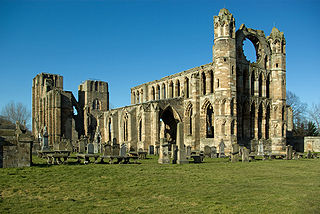
Elgin Cathedral is a historic ruin in Elgin, Moray, north-east Scotland. The cathedral—dedicated to the Holy Trinity—was established in 1224 on land granted by King Alexander II outside the burgh of Elgin and close to the River Lossie. It replaced the cathedral at Spynie, 3 kilometres (1.9 mi) to the north, that was served by a small chapter of eight clerics. The new and bigger cathedral was staffed with 18 canons in 1226 and then increased to 23 by 1242. After a damaging fire in 1270, a rebuilding programme greatly enlarged the building. It was unaffected by the Wars of Scottish Independence but again suffered extensive fire damage in 1390 following an attack by Robert III's brother Alexander Stewart, Earl of Buchan, also known as the Wolf of Badenoch. In 1402 the cathedral precinct again suffered an incendiary attack by the followers of the Lord of the Isles. The number of clerics required to staff the cathedral continued to grow, as did the number of craftsmen needed to maintain the buildings and surrounds.
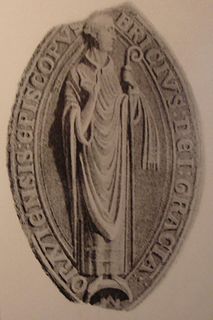
Bricius was prior of Lesmahagow and afterward bishop of Moray.
Andreas de Moravia was a 13th-century Scottish bishop. He may have been from the "de Moravia" family of Flemish origin who were lords of Duffus and other areas in the Greater Moray region in this period. In the time of Bishop Bricius' episcopate (1203–1222), there was a man called "Andreas" who was rector of the church of St. Peter at Duffus, and this may well have been this Andreas. He may also have been a native Scot.

Henry de Lichton [de Lychtone, Leighton] was a medieval Scottish prelate and diplomat, who, serving as Bishop of Moray (1414–1422) and Bishop of Aberdeen (1422–1440), became a significant patron of the church, a cathedral builder, and a writer. He also served King James I of Scotland as a diplomat in England, France, and Italy.
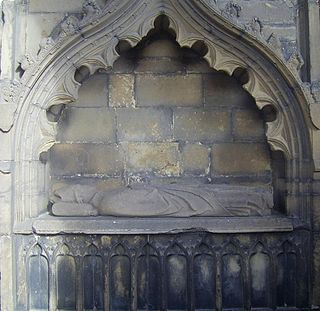
John de Winchester was a 15th-century English cleric who distinguished himself as an administrator and bishop in Scotland. Winchester was a student of canon law from 1418, graduating with a bachelorate in 1421.

Columba de Dunbar was Bishop of Moray from 1422 until his death at Spynie Palace near Elgin sometime before 7 November 1435.
William was a 12th-century prelate based in the Kingdom of Scotland. He occurs in the records for the first time, 1152 x 1153, late in the reign of King David I of Scotland (1124–53) witnessing a grant from that monarch of the church of Clackmannan to the Abbot of Cambuskenneth. By this point in time he is already Bishop of Moray. The date of his accession is not known; all that can be said is that he must have become bishop some time, perhaps some considerable time, after 1128, the last certain point in the floruit of his predecessor Gregoir.
Simon de Tosny was a 12th-century Cistercian monk and prelate. Simon was a monk of Melrose Abbey, and served there until he moved to become Abbot of Coggeshall Abbey in Essex. He resigned this abbey in 1168, and returned to Melrose. In 1171, he was elected as Bishop of Moray, and was consecrated at St Andrews on 23 January 1172. He was a distant cousin of King William who may or may not have played some part in his election. His cathedral was at Birnie, Moray. He witnessed several charters and was present at the Council of Northampton in 1176. He is the first bishop named on the bishop-list in the Moray Registrum. He died on 17 September 1184 and was buried in Birnie Kirk. Aside from the brief episcopate of Andrew he was succeeded as bishop by Richard de Lincoln.
Richard de Lincoln was a medieval Anglo-Norman prelate. Although of English origin, he was a royal clerk in the administration of King William of Scotland. With royal support, he was elected Bishop of Moray on 1 March 1187 and was consecrated at St Andrews on 15 March by Bishop Hugh. His appointment during the rebellion of Donald MacWilliam in the north was to a dilapidated diocese. Only after MacWilliam's defeat in July could Bishop Richard begin the strengthening of his see. His episcopate marked an increase in royal patronage directed at the diocese of Moray. He witnessed many charters during his episcopate. He died in 1203, and was succeeded by Bricius de Douglas.

Archibald was a 13th-century Scottish prelate best known for involvement in a dispute with the Pope.
William de Spynie was a Scottish prelate. He was a canon of Moray by 1363 and Precentor (Chanter) of Aberdeen in 1371. By 1372 x 1373, he had exchanged the latter position with William Boyl for the Precentorship of Moray. He had become Dean of Aberdeen by 1388. It is possible he had become Dean of Dunkeld in 1397, though this may be a mistake in the source, "Aberdeen" rather than "Dunkeld" being meant. At any rate, in that year he was elected as the Bishop of Moray. He travelled to France and on September 1397 was consecrated as Bishop.
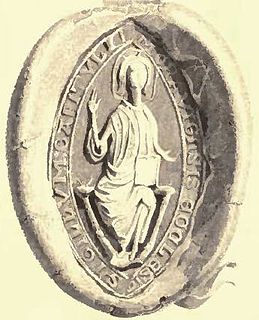
Andrew Stewart was a 15th-century Scottish prelate and administrator.
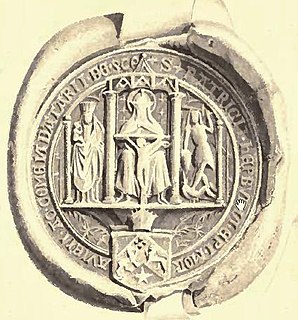
Patrick Hepburn was a 16th-century Scottish prelate. He was born in East Lothian, went to St Andrews University, entered the church, and then exploited his family connections to become Prior of St Andrews and royal secretary. Hepburn moved on to become Bishop of Moray and Commendator of Scone and played an ambiguous role in the Scottish Reformation. During this time he held a notorious reputation for immorality. He was deprived of his ecclesiastical titles two years before his death in 1573.
Alexander Douglas was a Church of Scotland minister and bishop. Minister at Elgin for 17 years, he was elevated to the bishopric of Moray, receiving crown provision on 30 November 1602. He was not consecrated, however, for over eight years, not until he received consecration at Edinburgh on 15 March 1611. He died 11 May 1623, at Elgin. He was buried in his cathedral, the church of St Giles, Elgin, in a vault by a window.
Alexander Bur was a 14th-century Scottish cleric. It is highly possible that Bur came from somewhere in or around Aberdeenshire, although that is not certain and is only based on the knowledge that Aberdeenshire is where other people bearing his surname come from in this period. He entered the service of King David II of Scotland sometime after 1343, perhaps as a member of David's exiled court at Château Gaillard. Although Alexander by this point in time already held prebends in both the bishopric of Aberdeen and the bishopric of Dunkeld, on that date King David petitioned Pope Clement VI for another canonry in the bishopric of Moray. Alexander had become a royal clerk and had obtained a Licentiate in Canon Law by 1350. By the latter date, upon the death of Adam Penny, Archdeacon of Moray, Alexander himself became Archdeacon.

Gilbert was a 13th-century Cistercian monk, abbot and bishop. His first appearance in the sources occurs under the year 1233, for which year the Chronicle of Melrose reported that "Sir Gilbert, the abbot of Glenluce, resigned his office, in the chapter of Melrose; and there he made his profession". It is not clear why Gilbert really did resign the position of Abbot of Glenluce, head of Glenluce Abbey in Galloway, in order to become a mere brother at Melrose Abbey; nor is it clear for how long Gilbert had been abbot, though his latest known predecessor is attested last on 27 May 1222. After going to there, Gilbert became the Master of the Novices at Melrose.
Odo Ydonc was a 13th-century Premonstratensian prelate. The first recorded appearance of Odo was when he witnessed a charter by Donnchadh, Earl of Carrick, on 21 July 1225. In this document he is already Abbot of Dercongal, incidentally the first Abbot of Dercongal to appear on record.
Reinald Macer [also called Reginald] was a medieval Cistercian monk and bishop, active in the Kingdom of Scotland during the reign of William the Lion. Originally a monk of Melrose Abbey, he rose to become Bishop of Ross in 1195, and held this position until his death in 1213. He is given the nickname Macer in Roger of Howden's Chronica, a French word that meant "skinny".
Alexander de Kylwos – written alternatively as Frylquhous, Kylquos, and a variety of other forms – was a Scottish churchman and prelate active in the second half of the 14th century. He is known to have held senior positions in three bishoprics, and senior offices in two, before being elected and appointed Bishop of Ross in 1371. Though his episcopate is relatively obscure, he seems to have spent almost all of it inside or around his province, was closely associated with William III and Euphemia I, successive rulers of Ross, and was an associate of the famous Alexander Bur, Bishop of Moray, during the latter's struggle with Alexander Stewart, the son of the King later known by the nickname "Wolf of Badenoch".
Radulf is an obscure churchman in early 13th-century Scotland, elected as Bishop of Dunblane some time between 1223 and 1225. The first of only two notices of his existence occurs in an Arbroath Abbey deed where he is styled "Radulf elect of Dunblane"; the document can be dated to 1223–1225. On 12 January 1226 Pope Honorius III instructed the Bishop of St Andrews, the Bishop of Moray and the Bishop of Caithness, to enjoin a new election for the bishopric of Dunblane, as "R. elected Bishop of Dunblane" had resigned in the Pope's presence a short time before. There are no clues as to Radulf's career after that. The Cathedral chapter of the diocese elected one Osbert in his place. Cockburn suggested Radulf was probably a Frenchman who had immigrated to Scotland, who got elected Bishop, but decided he would rather stay in Continental Europe after he travelled there for consecration, perhaps being offered a better post there.
References
- Dowden, John, The Bishops of Scotland, ed. J. Maitland Thomson, (Glasgow, 1912)
- Keith, Robert, An Historical Catalogue of the Scottish Bishops: Down to the Year 1688, (London, 1924)
- Richard Fawcett and Richard Oram, Elgin Cathedral and the Diocese of Moray, (Edinburgh, 2014)
- Watt, D.E.R. & A. L. Murray, Fasti Ecclesiae Scotinanae Medii Aevi ad annum 1638, Revised edition, (Edinburgh, 2003)
| Religious titles | ||
|---|---|---|
| Preceded by Simon de Gunby | Bishop of Moray 1252 | Succeeded by Archibald |